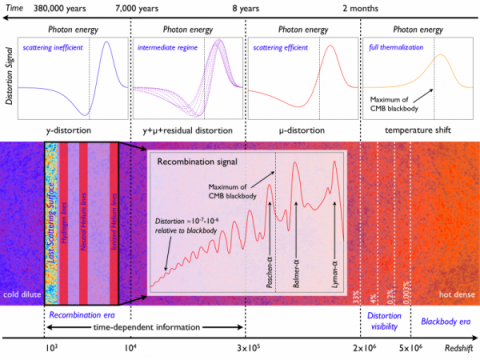Measurements of the cosmic microwave background (CMB) temperature and polarization anisotropies have undoubtedly taught us a lot about the Universe we live in, allowing us to pin down the key cosmological parameters to unprecedented precision. However, the CMB contains another invaluable piece of information that will become available in the future: the CMB frequency spectrum. From observations with COBE/FIRAS we know that the average (all-sky) CMB spectrum is extremely close (better than 1 part in 104) to a blackbody with a temperature of 2.7255 K. This measurement was awarded the Nobel Prize in Physics 2006 and already rules out many non-standard cosmological models.
However, this is not the end of the story, since even within the standard cosmological paradigm several processes exist that should inevitably lead to tiny deviations from a perfect thermal spectrum, far below (around 100–1000 times) the sensitivity of COBE/FIRAS but within reach of present-day technology. These spectral distortions will tell us about processes in the early Universe that affect the thermal history due to early energy release or photon production.
By measuring these distortions, we will open a new, unexplored window to the pre-recombination, high-redshift Universe. This could teach us more about the small-scale fluctuations created by inflation at scales inaccessible by an other means. We should also be able to detect the faint, redshifted recombination lines from the hydrogen and helium plasma emitted some 400,000 years after the Big Bang. This distortion can be predicted with very high precision and any deviation from this recombination fingerprint directly implies non-standard physics. The formation of structures and ignition of the first stars during reionization will furthermore heat the cosmic matter and, through Compton up-scattering of CMB photons, create a distortion that will be a large signal for future spectrometers.
Researchers at KICC pioneered some of the most detailed calculations for these processes, highlighting the range of signals that could be expected (see figure below). The flexible thermalization CosmoTherm was developed specifically for this purpose and currently new extensions are being developed to cover an even wider range of scenarios.
In addition to the standard sources of distortions described above, future CMB spectroscopy will also allow us to constrain non-standard physics. Energy release by decaying or annihilating particles will create CMB spectral distortions. Similarly, the evaporation of primordial black holes, dissipation of early magnetic fields and even superstrings, to name a few, could leave their traces in the CMB spectrum. All this highlights the great potential of this new window to the early Universe, a window that complements other efforts related to B-mode polarization searches, which currently are one of the great efforts of the CMB community. Researchers at KICC are heavily involved developing all of these directions and have stimulated several new experimental initiatives with which they are now involved including space-based concepts like PIXIE and PRISM, and also ground-based efforts such as APSERA.

Figure: Illustration of different distortions signals. Energy release creates the broad µ and y-type distortions through Compton interactions between free electrons and CMB photons. At very early times, thermalization is very efficient and no observable distortion remains. The cosmological recombination era shows several stages of photon production, creating the recombination fingerprint that should be observable in the cm–dm bands today. Figure adapted from Silk & Chluba (2014).


